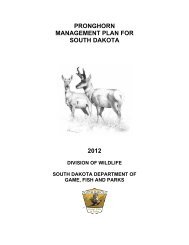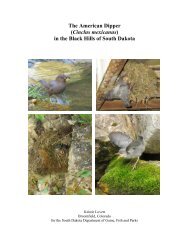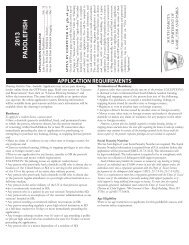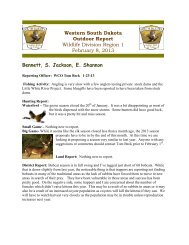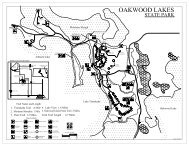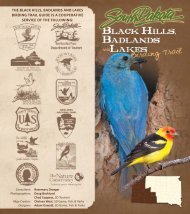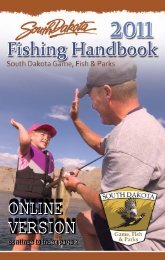pdf version - South Dakota Department of Game, Fish and Parks
pdf version - South Dakota Department of Game, Fish and Parks
pdf version - South Dakota Department of Game, Fish and Parks
Create successful ePaper yourself
Turn your PDF publications into a flip-book with our unique Google optimized e-Paper software.
Channel Catfi sh<br />
Ictalurus punctatus<br />
Quick key characteristics: The channel catfi sh primarily is found in warmwater<br />
habitats. It is scaleless with an elongated anal fi n, an adipose fi n, <strong>and</strong> sharp,<br />
venomous spines on front edges <strong>of</strong> the dorsal <strong>and</strong> pectoral fi ns. It has a wide,<br />
frontward-facing mouth, with a rounded, snout <strong>and</strong> over-hanging upper jaw. Its<br />
body shape is relatively tubular <strong>and</strong> it has prominent snout, mouth, <strong>and</strong> chin barbels.<br />
Similar species in <strong>South</strong> <strong>Dakota</strong>: other catfi sh<br />
Identifi cation: The combination <strong>of</strong> (1) a deeply forked tail (caudal) fi n, (2)<br />
rounded anal fi n, (3) presence <strong>of</strong> dark spots <strong>and</strong> a black caudal-fi n margin<br />
(especially in young individuals), <strong>and</strong> (4) prominent serrations on the back<br />
edge <strong>of</strong> pectoral fi n spines distinguishes the channel catfi sh from similar<br />
fi shes in <strong>South</strong> <strong>Dakota</strong>.<br />
Range: The channel catfi sh is native to river basins fl owing into the Gulf<br />
<strong>of</strong> Mexico, including the Mississippi River, <strong>and</strong> portions <strong>of</strong> the Great Lakes<br />
basin. It is widespread in larger streams, lakes, <strong>and</strong> rivers <strong>of</strong> <strong>South</strong> <strong>Dakota</strong>,<br />
<strong>and</strong> is the predominant sport fi sh in turbid rivers where larger individuals<br />
occupy pools, especially those associated with logs <strong>and</strong> brush.<br />
Items <strong>of</strong> interest:<br />
• Feeds on insects, crustaceans, fi sh (live or dead), <strong>and</strong> detritus<br />
• May undertake migrations in spring<br />
to spawn in small streams<br />
• Breeding males may take on a darker,<br />
blue-black coloration, causing<br />
confusion with blue catfi sh<br />
• Breeding males guard their eggs <strong>and</strong><br />
young<br />
• May exceed 47 in. <strong>and</strong> 55 lbs.<br />
36








